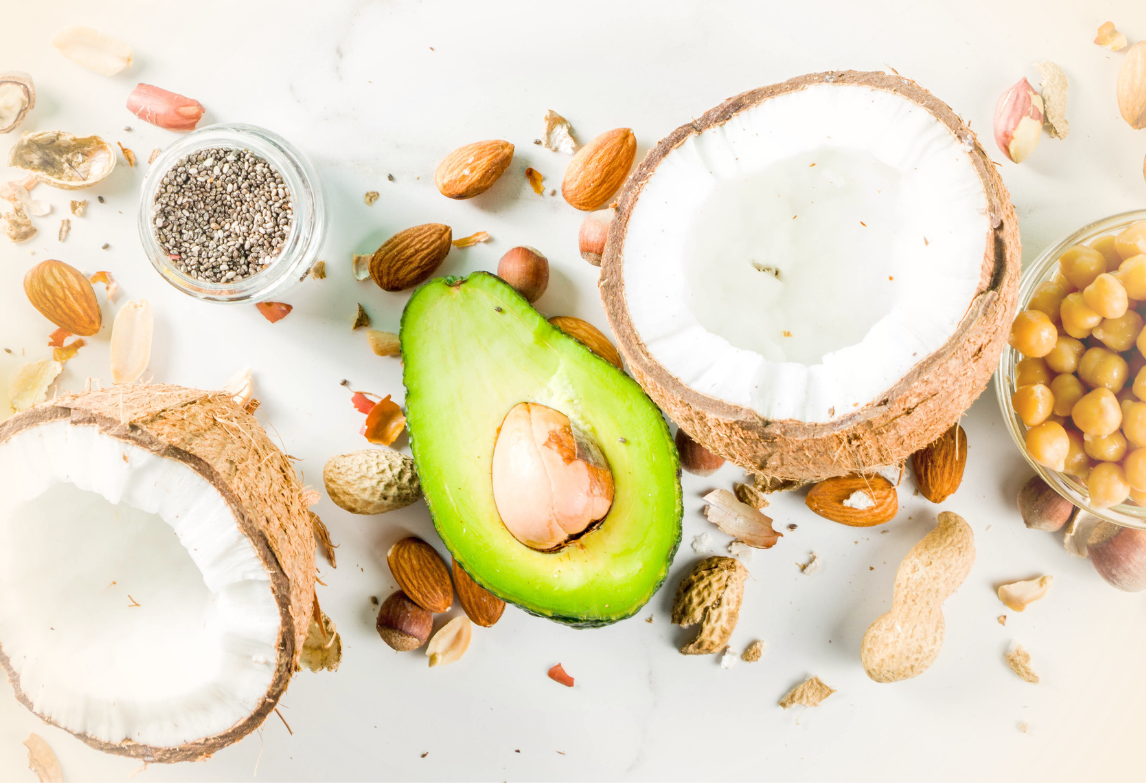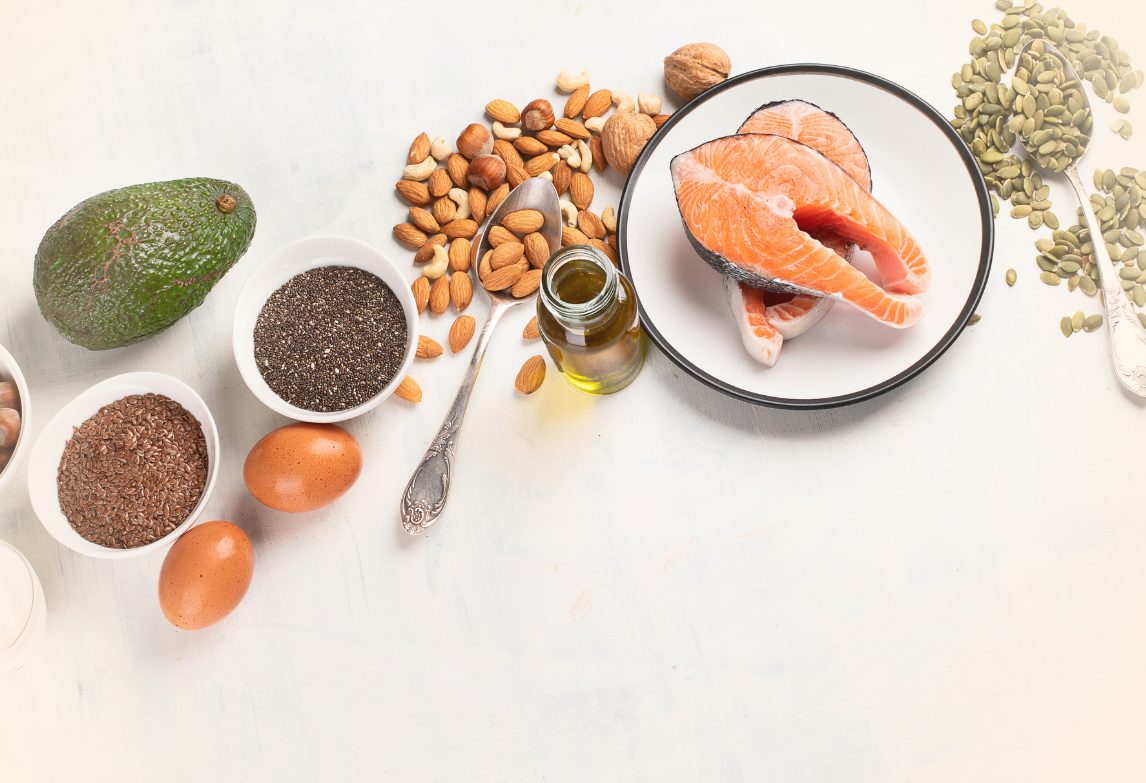When it comes to dietary fat intake, there are two kinds of people: the ones that can’t get enough and the ones that won’t go anywhere near it.
Unfortunately, both approaches are wrong. Like most topics in nutrition, dietary fats are complicated. There are different categories of them, some of which you should avoid and others that you literally can’t live without.
Learning the differences between the various types is the first step to making healthy choices about how to incorporate fats into a healthy diet.
Why Do I Need to Eat Fats?

The alarming problem of obesity in our society has spawned a multi-billion-dollar industry of fat-free meals and snacks that promise to restore you to a healthy weight without making any sacrifices. But what these companies don’t tell you is that when you give up dietary fat, you’re actually depriving your body of essential nutrients it needs to function.
Fat does a lot of good things for us. It keeps our bodies insulated, protects our internal organs, controls inflammation, builds nerve tissues and makes up hormones. It’s even responsible for keeping your hair and skin healthy. One of its most important functions is energy. According to the National Institute of Health, your body uses carbohydrates as its fuel source for the first 20 minutes of exercise, but after that, it begins burning fat from your body’s fat stores.1
Without fat, we would also have trouble absorbing enough of the four fat-soluble vitamins — vitamins A, D, E and K. These vitamins are essential for bone growth, immune health, blood clotting, protein synthesis, kidney function, vision, maintaining cell structure and wound healing, among many other things. And then there’s the fact that you cannot survive without them. There are certain essential fatty acids — linoleic acid and linolenic acid — that your body needs for survival and cannot produce itself, so they must be consumed in the diet.
When you opt for fat-free foods, you’re missing out on these potential benefits and possibly making it more difficult for your body to do its job and keep you alive.
The smarter play is to think more carefully about which types of fats you’re consuming. There are some you want to avoid, but there are others you may want to think about consuming more of. Here’s information on both types.
Which Dietary Fats Should I Avoid?
The two types of fats you want to eliminate from your diet as much as possible are: saturated fats and trans fats. Foods containing these types of fats are usually solid at room temperature, like lard, butter, shortening and stick margarine, and consuming a lot of them can lead to a host of health problems.
Trans Fat
While trans fat does exist naturally in certain foods in small quantities, the majority of it is manmade, through a manufacturing process known as hydrogenation, which turns healthy oils – including olive, canola and sunflower oils – into a solid form in order to keep them from going bad.
These are the fats that deserve to be demonised, because they can contribute to a number of diseases and they offer you nothing good in return. They increase your low-density lipoproteins (LDL, also known as bad cholesterol) levels and they lower your good cholesterol, or high-density lipoproteins (HDL). This is one of the key contributors to heart issues, and according to the Harvard Medical School, for every 2 percent of calories from trans fat that you consume each day, you’re increasing your risk for heart disease by 23 percent (2). Trans fats also contribute to inflammation in the body, and they may cause insulin resistance as well (3). This inhibits the body’s ability to remove sugar from the blood, resulting in high blood sugar levels.
Many governmental organisations are now taking steps to remove artificial trans fats from processed foods in response to the growing body of evidence that they contribute to heart disease (
4). However, it has allowed food manufacturers a three-year grace period in which to change their practices, and it enables them to petition the FDA for specific uses of certain partially hydrogenated oils — the main source of trans fats. Trans fats won’t disappear off of nutrition labels, though. They are naturally present in meat and dairy products and certain types of healthy oils in small quantities.
The smartest thing for consumers to do is to read product labels carefully before making a purchase. And don’t let yourself be fooled by labels that say “no trans fat.” The law only requires companies to report trans fat if there is more than half a gram present. To be sure that there isn’t some going unreported, check the label for “hydrogenated” or “partially hydrogenated oil.”
Saturated Fat
While not as bad as trans fats, saturated fats should still be avoided as much as possible. These fats come primarily from animal sources, including poultry, red meat and full-fat dairy products. Like trans fats, saturated fats are known to raise your LDL levels and to increase your risk of related diseases.
While various health organizations agree that you should minimize the amount of trans fats you consume, there’s some disagreement about just how much saturated fat you can safely consume. The 2015-2020 U.S. Dietary Guidelines recommend letting saturated fats take up no more than 10 percent of your daily calories, while the American Heart Association suggests a maximum of 5 to 6 percent of your daily caloric intake.
Both sources do agree that it’s better to avoid these fats as much as possible and instead opt for healthier fats.
Which Dietary Fats Are Good for Me?
There are two main types of good fat: monounsaturated fats and polyunsaturated fats. These are usually liquids at room temperature — think olive oil, canola oil and omega-3s.

Monounsaturated Fats
Monounsaturated fats are found in a variety of foods and oils, including:
- Olive oil
- Canola oil
- Avocadoes
- Most nuts
- High-oleic sunflower oil
- High-oleic safflower oil
- Peanut butter
They help to lower your bad cholesterol and raise your good cholesterol, which in turn helps to lower your risk of heart disease. Studies have also suggested that consuming monounsaturated fats can help with insulin sensitivity, enabling the body to use the sugars that enter the body more efficiently (7). This is essential for the maintenance of healthy blood sugar levels and the prevention of diabetes.
Polyunsaturated Fats
Polyunsaturated fats come in two main categories: omega-3s and omega-6s. Chances are that you’ve been encouraged to eat certain oily fish (salmon, tuna, mackerel, sardines, trout) in order to obtain their valuable omega-3s, and there’s a good reason for this.
Omega-3s help to reduce your risk of heart disease, and one variety in particular, alpha-linolenic acid (ALA), produces linolenic acid, one of the essential fatty acids your body needs to obtain from food. This helps your body build its cell membranes and nerve coverings, and it also plays a role in blood clotting.
Omega-6s are another popular type of polyunsaturated fat. Like omega-3s, omega-6s protect against heart disease and contain essential fatty acids. They also contribute to healthy skin and bone growth, as well as metabolic activity.
It is possible to obtain these fats from animal sources, like fish, and they are also present in plants like soybeans, legumes and nuts. But you’ll find them most commonly in oils, including:
- Soybean oil
- Sunflower oil
- Safflower oil
- Walnut oil
- Flaxseed oil
- Grapeseed oil
Interestingly enough, omega-3 acids have an anti-inflammatory effect while omega-6 acids have a pro-inflammatory effect, and the average Australian diet contains approximately 8 times more omega-6s than omega-3s.
But don’t let that scare you off of omega-6s entirely — they are still essential fatty acids, after all. However, you should try to be mindful of the balance between omega-3s and omega-6s (8).
According to a study by the POS Pilot Plant Corporation, the best oils in terms of omega-3 to omega-6 ratio are flaxseed oil, canola oil and soybean oil (9). Consider choosing one of these for cooking or sautéing.
Everything in Moderation
Just because you’re choosing healthy monounsaturated and polyunsaturated fats instead of their unhealthier cousins doesn’t mean you should go overboard. After all, even the healthy fats still contain 9 calories per gram, compared to just four calories per gram for carbohydrates and proteins. These extra calories can add up quickly, and if your body can’t make use of it all, it will store it in your fat cells, resulting in weight gain.
General dietary guidelines recommend that fats make up no more than 35 percent of the daily calories consumed for anyone over the age of three (4).
It also suggests that fat could make up as little as 20 percent of your diet without causing any ill effects.
Ultimately, dietary fats, like everything else in nutrition, need to be consumed in moderation. Try to avoid a very high-fat diet, and when you do introduce fats, opt for healthier options like monounsaturated and polyunsaturated fats. Your body will thank you for it.
An inability to digest fats can often lead to a fat deficiency which can further lead to malnutrition. Find out more about supporting fat digestion here.
References
- U.S. National Library of Medicine. (2018). Dietary fats explained. National Institute of Health. Retrieved from medlineplus.gov
- Harvard Medical School. (2017, Aug. 22). The truth about fats: the good, the bad, and the in-between. Harvard Health Publishing. Retrieved from health.harvard.edu
- Angelieri, C.T., Barros, C.R., Siquiera-Catania, A., Ferreira, S.R. (2012, Jul.) Trans fatty acid intake is associated with insulin sensitivity but independently of inflammation. Brazilian Journal of Medical and Biological Research. 45(7): 625–631.
- United States Food and Drug Administration. (2015, Jun. 16). FDA Cuts Trans Fats in Processed Foods. U.S. Food and Drug Administration. Retrieved from www.fda.gov
- U.S. Office of Disease Prevention and Health Promotion (2015). Dietary Guidelines 2015-2020. U.S. Office of Disease Prevention and Health Promotion. Retrieved from health.gov
- American Heart Association (2015). Saturated Fat. American Heart Association. Retrieved from heart.org
- Risérus, U., Willett, W.C., Hu, F.B. (2009, Jan.). Dietary fats and prevention of type 2 diabetes. Progress in Lipid Research. 48(1): 44-51.
- Simopoulos, A.P. (2002, Oct.) The importance of the ratio of omega-6/omega-3 essential fatty acids. Biomedicine & Pharmacotherapy. 56(8):365-79.
- Marianchuk, M., Kolodziejczyk, P., Riley, W.W., (1995) Fatty acid profile of canola oil vs. other oils and fats from the North American market. H2: Human Nutrition and Chemistry. 3: 840-842.







Leave a Reply
Want to join the discussion?Feel free to contribute!